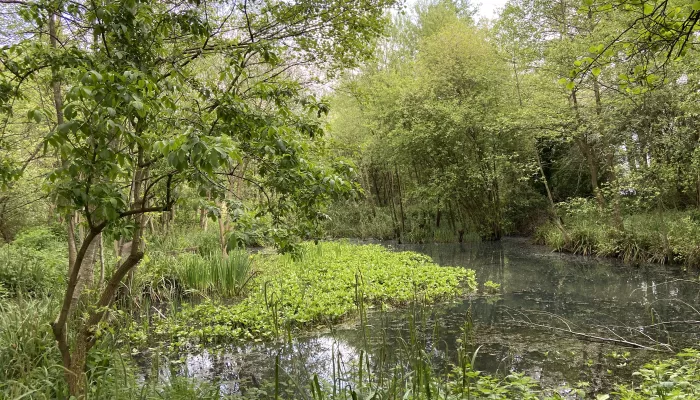
What would life be like without our woodlands?
Natasha Ruskin explores something terrifying: a world without woodlands.


Sevenoaks Wilder Kent Safari 2023 start point
We then set out on our Wilder Kent Safari and before long stumbled across our first superb shrub. The spindle is one of Paul’s favourites because of the bright orange berries that adorn the tree in the autumn, producing a profusion of colour that is hard not to marvel at. The name ‘spindle’ comes from the straight rods that grow on young trees that were used for hand spinning. We also discovered that the berries contain a mild insecticide and were known to be crushed up to make hair lice tonic!
We meandered onwards before we found a blackthorn shrub with its berries starting to form – perfect for making sloe gin come autumn when they are at their plumpest! Paul even shared his secret for the perfect sloe gin… adding flaked almonds (shh!). Paul’s voice then lowered as he told us the dark and scary connotations of the blackthorn plant with death and the devil. Algae and lichen often build on the sharp spines of blackthorn bushes and years ago, if you were to be scraped by one of these spikes, the wound might become infected and people would say evil spirits would enter the body. It’s safe to say we all took a wide berth from the blackthorn tree as we carried on our adventure.

Sevenoaks Wilder Kent Safari 2023 walking
As we continued our Safari, I started getting a bit peckish. Luckily for me, Paul identified some garlic mustard and offered for us to try some! Before I munched on a delicate green leaf sat below a crown of pretty white flowers, Paul suggested I check the underside of the leaf. I am so glad he did, because as I turned the leaf over, there were several orange specks dotted across – the eggs of the orange-tip butterfly! This didn’t deter me though, as we identified a suitably butterfly egg-free leaf and I tried my first taste of garlic mustard. As the name suggests, it was strongly garlic-y and mustard-y! Although this didn’t quite satiate my hunger, I was grateful to try something I’d never experienced before. It’s important to remember to only taste something you have foraged if you are with an expert or are 100% sure of your find.

Sevenoaks Wilder Kent Safari 2023 Garlic mustard and butterfly eggs
We even got more than we bargained for as we didn’t just dive into the folklore of the plants found at Sevenoaks. As we listened to lapwings calling on the lake and spotted some herons perched on one tall branches, Paul began to tell us the curious story behind the origins of barnacle geese. Barnacle geese would arrive in Britain over the winter, yet no one could explain where they came from as none were ever seen nesting or raising their goslings. The obvious explanation would be that the geese grow on a ‘barnacle goose tree’ until they dropped into the water and matured into each goose. Of course, now we know that barnacle geese migrate from Greenland and Iceland to overwinter in the UK and Europe, but this wasn’t discovered until the late 19th century.

Sevenoaks Safari Barnacle Geese tree
Perhaps my favourite moment on the safari was when we came across some gorse plants. You may know of the saying “When gorse is in bloom, kissing’s in season”. The wonderful meaning behind this line is that although the peak flowering season for gorse is in June, it continues to flower throughout much of the year. Therefore, kissing is never out of fashion! This lovely line originates all the way back to the mid 19th century.
I could go on with the endless nuggets of wisdom and curious tales that Paul peppered throughout our engaging stroll through Sevenoaks Wildlife Reserve, but you’ll just have to join one of his fascinating safaris yourselves to uncover even more secrets. We only walked a small loop of the reserve, but it is amazing how much we learnt! It was incredibly easy getting to the safari; I travelled from London and it was just a short walk from Sevenoaks station to the reserve, but there is also car parking and bike racks available. Because the safari route takes you on a loop which starts and ends at the Visitor Centre, I was able to have a chat with the lovely Visitor Centre staff as I stopped in for some refreshments – very welcomed as learning all about the food, folklore and fantasy of Sevenoaks is thirsty work!

Natasha Ruskin explores something terrifying: a world without woodlands.

Ever wondered how planting trees or restoring soil can help fight climate change? Carbon sequestration is nature’s quiet housekeeping - learn more in this blog.

Healthy ecosystems give us everything we need to survive: water, clean air, food, and raw materials for building, making medicines... Learn more here.